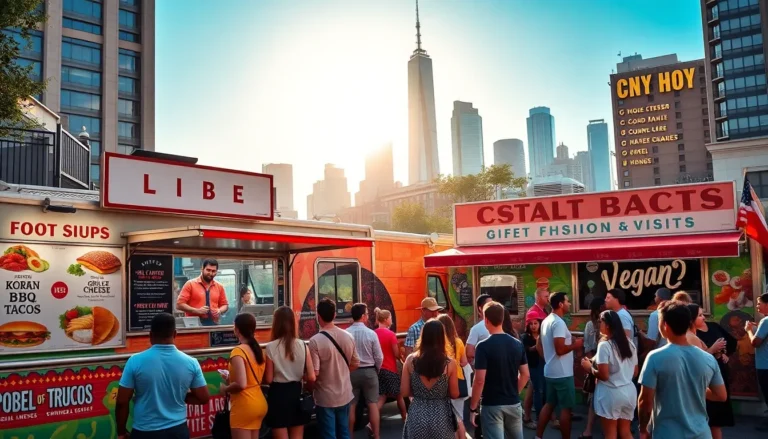In the age of social media, food trends can spread faster than a cat video on a lazy Sunday. One minute, everyone’s raving about whipped coffee, and the next, it’s all about the latest rainbow bagel creation. These viral food fads not only tantalize taste buds but also ignite creativity in kitchens around the world.
From bizarre flavor combinations to eye-catching presentations, these trends often leave us wondering: who comes up with this stuff? Whether it’s a quirky twist on a classic dish or a colorful dessert that looks too good to eat, viral food trends are more than just a feast for the eyes—they’re a chance to join a culinary movement. So grab your phone and get ready to explore the deliciously wild world of food trends that are capturing hearts, one Instagram post at a time.
Table of Contents
ToggleOverview of Viral Food Trends
Viral food trends capture attention quickly, thanks to the influence of social media. They showcase creativity and innovation, leading to unique culinary experiences.
Definition and Characteristics
Viral food trends represent dishes or recipes that gain significant popularity through online sharing. These trends often feature striking visuals and unique flavor profiles. Creativity defines these trends, as chefs and home cooks experiment with unusual ingredients. Platforms like Instagram and TikTok drive these trends, allowing users to share their culinary creations. Instant accessibility enhances their appeal, as viewers can easily replicate these popular dishes.
Historical Context
The phenomenon of viral food trends isn’t new. Earlier decades saw food fads introduced through television or print media. However, the rise of social media amplified their reach and speed. In the early 2000s, trendy items like cupcake shops emerged, capturing public interest. Instagram’s launch in 2010 marked a turning point, making visually appealing food shareable. Trends can now go global within days, influencing eating habits and restaurant menus worldwide.
Popular Viral Food Trends

Social media has sparked interest in numerous food trends, each gaining traction for its visual appeal and unique flavors. Dalgona coffee, cloud bread, and baked feta pasta highlight this phenomenon.
Dalgona Coffee
Dalgona coffee gained global attention early in the pandemic. It features whipped coffee made with equal parts instant coffee, sugar, and hot water. The mixture is whipped until fluffy and served over milk. Its striking appearance and ease of preparation contributed to its viral success. Users share numerous creative variations, enhancing its popularity across platforms like Instagram and TikTok.
Cloud Bread
Cloud bread emerged as a low-carb alternative to traditional bread. This fluffy creation consists of egg whites, cream cheese, and cream of tartar, combining for a light texture. Baked until golden, cloud bread offers a gluten-free option that appeals to health-conscious eaters. Its aesthetically pleasing shape leads to countless social media posts, inspiring others to try this trendy recipe.
Baked Feta Pasta
Baked feta pasta gained recognition for its simplicity and delicious flavor. The dish requires only cherry tomatoes, feta cheese, olive oil, and spices baked until creamy. Mixing the ingredients with pasta creates a rich, flavorful meal that captivates diners. Viral videos showcasing this recipe have prompted many to recreate it, contributing to its place in culinary discussions.
Social Media’s Influence on Food Trends
Social media dramatically reshapes how food trends emerge and spread. Platforms provide an easy avenue for users to discover and share viral recipes and dishes.
Platforms Driving Growth
Instagram ranks among the leading platforms for food trend propagation. Users post visually appealing photos and videos of trendy recipes, making them instantly recognizable. TikTok quickly follows, offering short, engaging clips that simplify cooking processes. YouTube also plays a crucial role, showcasing longer tutorials that guide users through complex dishes. These platforms foster communities around food, enabling global participation and exchange of ideas. In fact, many viral trends originate from user-generated content that encourages others to replicate and share.
Role of Influencers
Influencers significantly impact the growth of viral food trends. Chefs and food enthusiasts attract large followings by showcasing unique recipes and culinary hacks. Their endorsements can propel obscure dishes into mainstream consciousness almost overnight. Influencers often create challenges or trends that engage followers, further driving participation. Collaboration among influencers creates a ripple effect, expanding reach across various demographics. Ultimately, their recommendations shape culinary preferences, influencing what appears on restaurant menus and home kitchens worldwide.
Impact of Viral Food Trends
Viral food trends significantly reshape the culinary landscape. They create cultural conversations and influence individual eating habits worldwide.
Cultural Significance
Viral food trends often reflect society’s values and desires. They unite people through shared experiences around food, fostering community and connection. Trends like Dalgona coffee often emerge during challenging times and symbolize adaptability and creativity. Such dishes also encourage cultural exchange and appreciation, as different cuisines gain exposure through platforms like TikTok and Instagram. Users enjoy more than just food; they explore each other’s traditions and innovation in the kitchen. This exchange enhances culinary diversity and inspires chefs to push boundaries, creating unique flavors that resonate globally.
Economic Impact on the Food Industry
Viral food trends generate substantial economic activity within the food industry. Restaurants frequently adjust menus to incorporate popular items, attracting more customers eager to try the latest dishes. This shift increases sales and inspires the creation of new products, such as specialty ingredients tied to trending recipes. Influencers not only promote these trends but also influence consumer purchasing behavior, leading to spikes in demand for specific ingredients. Supply chains adapt quickly to meet these changes, promoting local sourcing and fostering small businesses. Overall, viral trends shape market dynamics, stimulating innovation and enhancing economic growth in the culinary sector.
Viral food trends are more than just fleeting moments in the culinary world. They reflect a dynamic interplay between creativity and community engagement. As social media continues to shape how people discover and share food experiences, these trends foster connections among food enthusiasts worldwide.
From the comforting allure of Dalgona coffee to the playful nature of cloud bread, each trend offers a unique glimpse into contemporary tastes and values. The impact of these trends extends beyond individual kitchens, influencing menus and driving economic activity within the food industry.
As new trends emerge, they invite everyone to explore and experiment in their kitchens, making the culinary landscape richer and more diverse. Embracing these trends not only enhances personal cooking experiences but also connects individuals to a larger global conversation about food.


